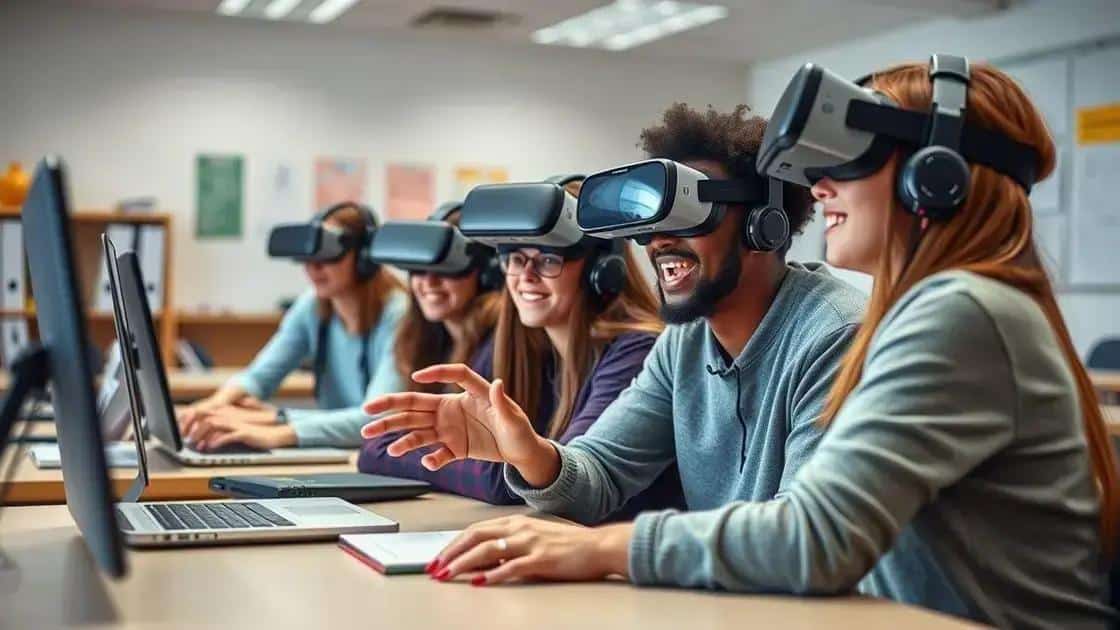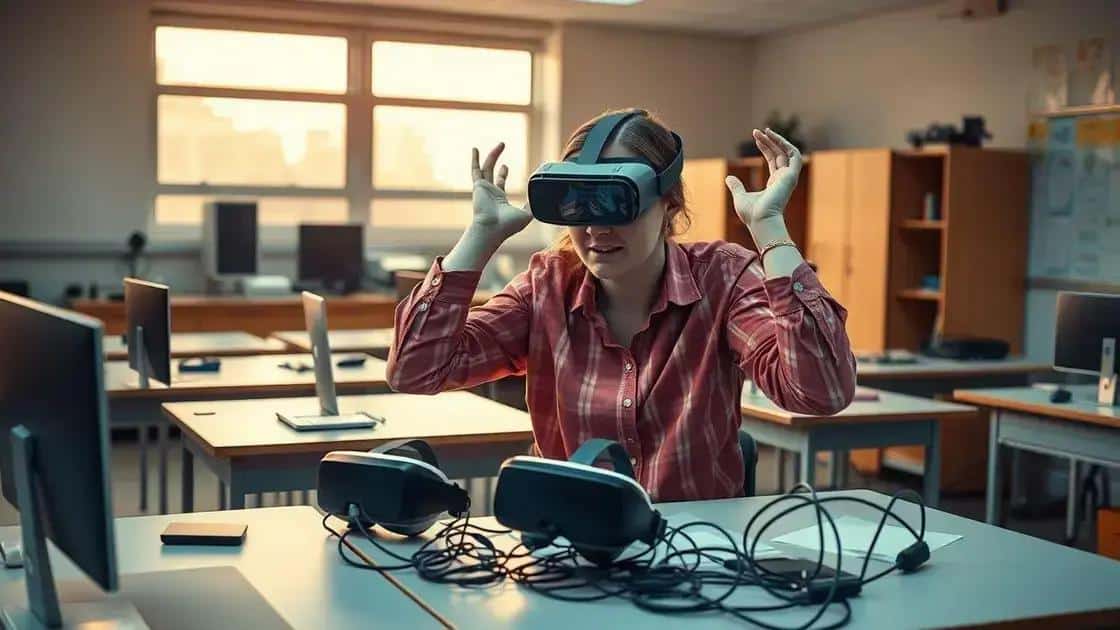VR learning environments trends: shaping the future

VR learning environments trends enhance education by increasing engagement, providing immersive experiences, and improving collaboration, while challenges include costs, technical issues, and the need for teacher training.
VR learning environments trends are rapidly changing the landscape of education. Have you ever imagined stepping into a virtual classroom where the world becomes your textbook? Let’s explore how these innovations are creating immersive experiences for learners.
Understanding the evolution of VR in education
The evolution of VR in education has opened up exciting possibilities for learners. Over the years, educational institutions have embraced immersive technologies to enhance the way students engage with content. Think about it: how would it feel to dissect a virtual frog or walk through ancient ruins without leaving the classroom?
The Early Days of VR
Initially, VR was a concept mainly explored by tech enthusiasts. The technology was bulky and expensive, making it impractical for typical classrooms. However, as advances occurred, VR became more accessible. Educational institutions began to recognize its potential.
Today’s Accessibility
Now, with devices like Oculus Rift and Google Cardboard, VR learning is reaching new heights. Schools can now integrate this amazing technology into various subjects, from science to history. This accessibility transforms traditional learning methods into engaging experiences.
- VR enables real-world exploration without limits.
- Students can practice skills in a safe environment.
- Creative learning spaces enhance collaboration.
As we progress, the importance of VR expands. Educational institutions are constantly exploring how to improve learning outcomes through technology. In subjects that require hands-on experiences, VR learning environments can significantly enhance understanding. Imagine students virtually visiting historical sites or practicing surgeries in a simulated environment.
Collaboration and Interaction
Collaboration is a key benefit of VR in education. Students can work together within immersive environments, making learning more interactive. This form of learning encourages teamwork, problem-solving, and communication, essential skills for the 21st century.
- Students learn to collaborate in virtual teams.
- Problem-solving skills are enhanced through interactive challenges.
- Communication improves in shared experiences.
Not only does VR transform engagement and collaboration, but it also prepares students for future work environments where virtual interaction becomes the norm. This evolving technology shows promise, but educators must continually adjust their strategies to maximize its benefits.
Key benefits of VR learning environments

The key benefits of VR learning environments extend beyond just engagement. These immersive experiences help students grasp complex concepts in an innovative way. Imagine being able to explore the human body or travel to different countries, all from your classroom!
Enhanced Engagement
Students are naturally drawn to technology, and VR taps into that interest. By using VR technology, classrooms become dynamic learning spaces. This excitement motivates students to participate actively.
Real-World Experience
One of the most significant advantages of VR is that it allows students to experience real-world situations virtually. They can practice skills such as conducting experiments or performing art techniques, making learning both practical and fun.
- Virtual field trips bring history to life.
- Science experiments can be performed without safety concerns.
- Students can practice foreign languages in simulated environments.
Additionally, VR learning environments promote better retention. When students can visualize and interact with the learning material, they are more likely to remember it. This method enhances understanding by creating a memorable experience rather than just passive learning.
Improved Collaboration
Another important benefit is the enhancement of collaboration among students. When using VR together, students can work on projects that require teamwork. This setting fosters communication and interaction, essential for developing social skills.
- Group projects encourage teamwork.
- Students learn to communicate effectively in virtual settings.
- Problem-solving is more engaging when tackled as a group.
In summary, VR learning environments offer numerous advantages that enhance traditional education. They make learning more engaging, realistic, and necessary collaboration among students. As technology continues to develop, the potential for VR in education will only grow.
Current trends shaping VR education
The current trends shaping VR education are bringing about significant changes in how students learn. As technology evolves, so do the ways we integrate virtual reality into educational frameworks. This dynamic shift is making learning more engaging and accessible.
Increased Affordability
One major trend is the decreasing cost of VR technology. Devices are becoming more affordable, allowing schools to purchase headsets and software. This accessibility is essential for wider adoption in classrooms. As prices continue to drop, more institutions can implement these tools.
Integration of AI
Another exciting development is the integration of artificial intelligence (AI) into VR experiences. AI can personalize learning for each student, adapting lessons based on their progress and preferences. This tailored approach ensures that every learner receives the support they need.
- AI-driven analytics help educators track student progress.
- Adaptive learning paths enhance individual experiences.
- Engagement increases through interactive AI features.
Moreover, educational content is becoming increasingly immersive. Developers are creating virtual worlds that not only teach but also captivate students. Languages, history, and science come alive in ways that textbooks cannot match. For instance, students can explore ancient civilizations or conduct virtual science experiments.
Collaborative Learning
Collaboration is another trend that’s gaining traction. Virtual reality platforms enable students from different locations to interact and work together in real time. This interactive environment promotes teamwork and enhances communication skills.
- Students can collaborate on projects in shared virtual spaces.
- Group activities foster a sense of community.
- Virtual interactions simulate real-life teamwork scenarios.
As these trends continue to evolve, the landscape of VR education will transform further. Teachers and students are finding new ways to harness the power of virtual reality, paving the way for a richer educational experience.
Challenges in implementing VR in classrooms

The challenges in implementing VR in classrooms are significant and varied. While the benefits are clear, moving from traditional methods to immersive technology comes with hurdles. Addressing these obstacles is crucial for successful adoption.
Cost of Technology
One major challenge is the high cost of VR equipment and software. Schools often have limited budgets and may struggle to fund the purchase of VR headsets, computers, and the necessary software. This financial barrier can prevent many schools from using this technology effectively.
Technical Issues and Infrastructure
Another issue is the technical difficulties that can arise. Many schools lack the infrastructure to support VR technology. Issues like unreliable Wi-Fi, insufficient computer hardware, and inadequate technical support can hinder the effective implementation of VR in the classroom.
- Wi-Fi connectivity can impact the use of VR applications.
- Not all computers meet the hardware requirements for VR.
- Technical support may not be available on-site.
Beyond technical obstacles, there’s also the challenge of teacher training. Many educators need proper training to integrate VR into their curriculum. Without sufficient training, teachers may feel overwhelmed or unsure about how to use this technology effectively.
Curriculum Integration
Integrating VR into existing curricula can be complex. Teachers must find ways to link virtual experiences with lesson plans while ensuring that learning objectives are met. This process can take significant time and effort, which may deter educators.
- Finding appropriate VR content that aligns with educational standards is essential.
- Teachers may need to redesign lessons around VR experiences.
- Time constraints can make it challenging to implement new technologies.
Lastly, there are concerns about accessibility and inclusivity. Not all students may have the same comfort level with technology. Ensuring that every student can participate in VR activities is vital to fostering an inclusive learning environment.
In conclusion, while there are challenges to implementing VR in classrooms, the potential benefits are enormous. By understanding these obstacles, educators can better prepare for and navigate the integration of virtual reality into their teaching methods. It’s essential to focus on cost management, technical support, and professional training. Additionally, ensuring inclusivity will help all students benefit from this innovative technology. If schools can overcome these challenges, VR can significantly enhance learning experiences and outcomes.
FAQ – Questions about VR in Education
What are the main benefits of using VR in education?
VR enhances engagement, provides real-world experiences, and improves collaboration among students, making learning more dynamic.
What challenges do schools face when implementing VR?
Challenges include high costs for technology, technical issues with infrastructure, the need for teacher training, and ensuring curriculum integration.
How can VR technology be made more accessible in classrooms?
By securing funding, improving infrastructure, and providing training programs, schools can enhance access to VR technology for all students.
Is VR suitable for all age groups in education?
Yes, VR can be adapted for various age groups, with content designed to suit the learning needs and capabilities of different students.





